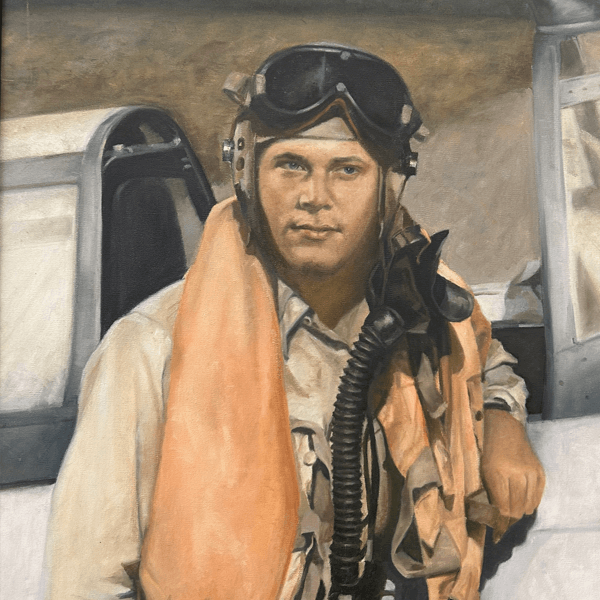Robert Patterson LaFollette

Robert Patterson LaFollette
Robert Patterson LaFollette was born May 23, 1920. He graduated from Erie Technical High School and was employed by Penn Union Electric as a metal pattern maker. When Pearl Harbor was bombed and the United States entered World War II, he entered cadet training in the U.S. Army Air Corps at San Antonio Cadet Center in Texas.
Flight training was divided into segments (i) Primary at Chickasaw, OK (light aircraft); (ii) Basic at Garden City, KS (more powerful aircraft and instruments); and (iii) Advanced at Eagle Pass, TX (AT-6 aircraft, instruments, retractable landing gear, then fighters). At the end of ten months of exhaustive training, he received his wings and was commissioned as a Second Lieutenant. Assigned to the 524th Fighter Bomber Squadron, 27th Group, he spent most of the war in the Italian theater. Being a fighter pilot was a solitary endeavor. Not only was he the pilot but also the navigator and the bombardier, responsible for all aspects of the flight, depending on his Crew Chief to see that necessary maintenance was performed and his Armorer to see that appropriate ammunition was loaded. As Squadron Commander, he was also responsible for the safety of the other pilots. Their job was to take out as many of the enemy and disable as many aircraft and transport vehicles as possible. Many missions were carried out at dawn with Allies coming out of the Sun to strafe or bomb aircraft, trains, and trucks before they could be camouflaged and hidden during daylight hours. They also performed escort duty, often clearing the way for the bombers. LaFollette was one of these courageous, resourceful, dedicated heroes. He became involved in the Battle for Anzio, supporting group troops attempting to cut the enemy’s main communications southeast of Rome and threaten the rear of the German XIV Corps. While the Allies avoided the destruction of religious and historic sites, the Germans recognized the strategic location of the Monastery of Monte Cassino, one of Christianity’s most sacred sites, as an essential component of German defenses overlooking the Liri Valley. Thus, it became a prime target during the battle for Monte Cassino and Allied bombs smashed it to rubble. It was later rebuilt with money provided by the United States. LaFollette was hit five times during the battle. Twice Captain LaFollette was able to nurse his plane back to base, however once he bellied the plane into Genoa harbor just past the shoreline approaching the Po Valley after trying to skip bomb a tunnel where flatcars were hidden and spent several hours in a dinghy before being rescued. He was shot down over Spezia. He once hit high-tension wires that became entangled in his propellers. The cockpit and crowbars had to be used to get him out. Making his way up the Italian “Boot” in a plane called Pinhead, Capt. LaFollette participated in the Italian Tactical Air Campaign in Operations: HUSKY, AVALANCE, ANZIO, MONTE CASSINO, STRANGLE, DIADEM, ANVIL-DRAGOON, PO VALLEY, and the Volturno Campaign. He was awarded the Distinguished Flying Cross when his squadron destroyed ten train locomotives. He earned many more awards, including seven Air Medals, the Army Presidential Unit Citation, the WWII Victory Medal, American Campaign Medal and the Armed Forces Expeditionary Medal, but for him and so many others, the primary reward was serving his country. During his tour, he became Squadron Operations Officer and flew many types of aircraft. For maneuverability, his favorite plane was the P-51 (the Mustang) and for endurance he favored the P-47 (the Jug). Although pilots were permitted to return to the States after 50 missions, he completed 102. On his return to America in 1947, while at Tindall AFB in Panama City, FL, Capt. LaFollette was Squadron Commander of the Pinball Outfit, which used to give gunners experience handling remote gunnery equipments. The gunner shot live ammunition at the training aircrafts, which were fitted with armor plates imbedded with sensors to record hits. The trainers returned fire with frangible bullets designed to pulverize on impact and record hits. However, some planes were actually shot down when the bullets malfunctioned. At the conclusion of the war, he was assigned to the Air Transport Command and flew war weary planes to Western bases. In 1947, he joined the Air Force Reserve and was assigned to Niagara Falls Air Force Base, flying with the “Weekend Warriors”, while transitioning to jet aircraft. As President of the Erie Chapter of the Air Force Association, he attended annual meetings in Washington, D.C., and received the Armed Forces Reserve Medal. Although LaFollette retired as a Major in 1977, he never lost interest in flying and kept track of Air Force technology, involving himself in annual air shows and attending group reunions.

